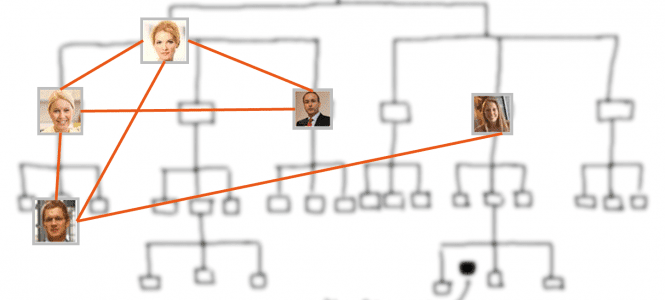
How communities of practice enable continuous improvements

It’s 20 years ago that Etienne Wenger wrote about “Communities of practice.” Since then a social media revolution has happened. More than a 17.8 Million professionals on LinkedIn are now members of 20 Million groups. This post is about how this behaviour can be replicated to accelerate transformations within companies.
To recap what a community of practice is:
“Communities of practice are groups of people who share a concern, a set of problems, or a passion about a topic, and who deepen their knowledge and expertise in this area by interacting on an ongoing basis.”
From Etienne Wenger’s book “Communities of Practice: Learning Meaning and Identity” from 1998.
Let’s look into why Communities of Practice matter when speaking about continuous improvement:
Why Do Communities of Practice Matter?
Communities of Practice (CoP) are important because they complement “the formal organisation” very well. The formal organisation is typically organised by functions and reporting lines. This view of an organisation is highly visible and the primary centre of attention. However, most of us, who have worked for large multinationals, know that much of the work that adds value happen through the business processes and the associated informal organisation that goes across the silos. For instance, people make informal connections across departments to support a new client with a special need. When such informal connections grow then they can evolve into more permanent CoPs that complement the formal organisation.
Why Communities of Practice Can Be Useful in Transformation Efforts
Large transformations often disrupt the formal organisation and hereby continuous improvement. Organisational structures change, reporting lines change and responsibilities change. This impact creates losers and winners. Above all it creates uncertainty. The people that derive most of their identity and sense of value from the formal organisation are therefore likely to be more sceptical of change.
So, why not avoid going head-to-head with the sceptics in the formal organisation by embracing the informal organisation with communities of practice? You can tap into relevant CoPs and harvest their wisdom and energy in the service of your transformation. If you succeed, then you get some of the people with the most knowledge, connections and informal power behind you. If not, then you are merely back to normal and it will be hard to ensure continuous improvement in the organisation.
How To Support Communities-of-practice In Supporting continuous improvement
CoPs are informal by nature. The people that thrive from interacting in such communities often don’t believe in the formal hierarchy. It, therefore, may seem counter-intuitive to support CoPs from the formal organisation. This is where we can learn from LinkedIn’s groups. In these groups professionals from across countries meet to form loosely coupled communities. The groups are mostly about exchanging viewpoints and general information on a topic (such as “Managing Transitions”). So, they may be regarded as loosely coupled communities but they are not “practice”. Why are they not closely connected with practice? LinkedIn groups rarely make concerted, joint efforts that change things. They mostly consist of people speaking together from their own perspective. There not any common ground and common purpose.
Developing a Common Language of Practice
To add more value inside an organisation and for continuous improvement to be effective one important element is missing: A common language of practice. How can different people work together if they don’t have a common language? This is where we see the business process coming in. It’s useful in the way that it connects all the important domains of change: Structure, information, activity flow and people. This puts the business process at the centre of any sustainable change towards continuous improvement. You must do more than just communicate or give workshops to anchor them in the organisation.
The challenge is that business processes often are invisible and the reserve of quality departments or IT people. The answer to this is to make a business process and continuous improvement more enjoyable to work with. If the business process can be made visible to everyone then it can help structure the conversation, the knowledge exchange and benefit continuous improvement. Through conversations that refer actively to the business process it will come real and alive for the people that work with it. When it becomes real, then it becomes easier to create awareness, desire, knowledge and ability in the service of the change.
LinkedIn has enabled small, emergent communities-of-practice to grow and become visible. Why not let the same happen to communities within your organisation and let it be a continuous improvement tool? If you can then add a common purpose, a good culture and the common language of the business process, then you may have a much more powerful mechanism to support your change…
Etienne Wenger touches upon the strategic value of CoPs in this short video:
Want to plan for communities of practice around your business processes?
Our Process Success Guide contains a full step-by-step guide to creating your own process improvement plan.
Frequently Asked Questions
Knowledge sharing within a community greatly contributes to continuous improvement and innovation by creating a collective intelligence pool. When individuals within a community share their insights, experiences, and ideas, they contribute to this collective pool, fostering an environment of education and feedback. This, in turn, spurs creativity and encourages members to challenge established norms or come up with new ideas, thereby driving innovation.
To illustrate the impact communities can have in fostering continuous improvement, consider the example of open-source software communities. These communities are composed of people from diverse backgrounds and with different skills, all coming together to work on a single project. They constantly collaborate, discuss, and iterate on the software, leading to continuous improvement of the product, innovation, and the community’s growth.
Addressing differences in ideas within a community is a challenging but essential task to avoid hindering continuous improvement. Communities typically establish guidelines and create an open environment where respectful discussion and debate are encouraged. This allows all ideas to be heard and assessed fairly, thereby avoiding any potential bias. Also, these disagreements often lead to a better understanding of the issue at hand and generate creative solutions that may not have been considered before, further bolstering continuous improvement.



